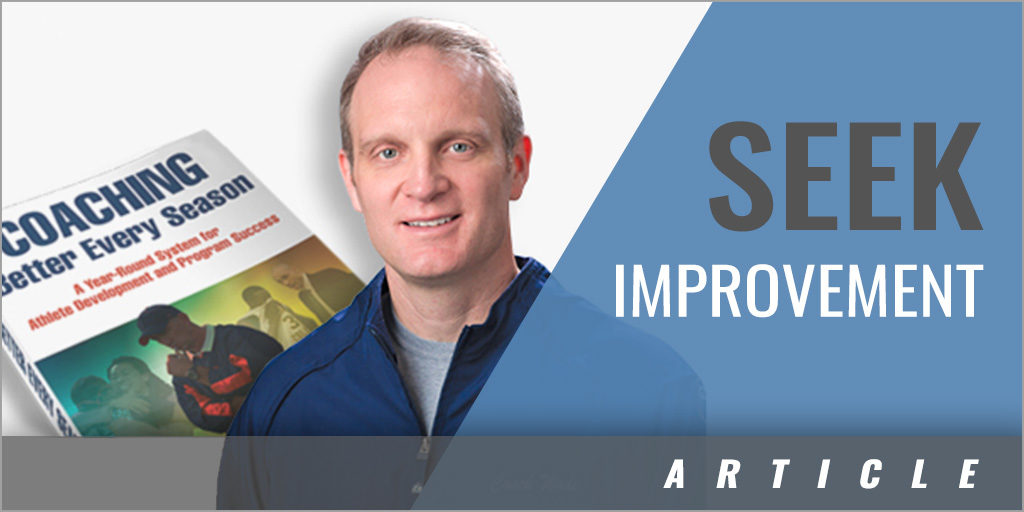|
By: Wade Gilbert Originally Published in: Coaching Better Every Season Provided by: Human Kinetics Successful coaches have an inner drive to change and evolve. This approach sustains their passion for coaching and keeps them fresh and excited for what is next. The best coaches are never content with resting on prior accomplishments; they are always trying to create a higher standard for the future. Four-time national football championship coach Nick Saban refers to continuous improvement as a standard of excellence, and, he says, The standard of excellence is always under construction, it's never complete. Across their careers coaches have to counterbalance the natural preference to stick with what works with efforts to adjust to the ever-changing demands of their sport and needs of their athletes. Some coaches, such as two-time NBA championship coach Erik Spoelstra, describe this as a willingness to reinvent themselves as coaches. Coach Spoelstra guided LeBron James and the Miami Heat to four straight championship finals, but he was quick to acknowledge that it required a never-ending commitment to finding new ways to improve: How many times have you reinvented yourself to become somebody new, somebody better? But in order to do that you have to be uncomfortable. You can't stay who you are...Things change and you have to be able to adapt. The combination of personal mastery and a growth mind-set for coaches provides the foundation for long-term, incremental, continuous improvement. Continuous improvement comes from a steady focus on deliberately closing performance gaps. Championship college and professional football coach Pete Carroll is a prime example of an effective coach who is committed to continuous improvement. He stated that all he tries to do is "just get a little better every day." The dramatic outcomes that can result from focusing on steady incremental progress toward shortening performance gaps was on full display in 2013-2014 when Coach Carroll lead the Seattle Seahawks to one of the most dominating championship victories in Super Bowl history. Many coaches have a tendency to try to fix too much at one time. As a result they can find themselves endlessly chasing, but never closing, performance gaps. Leadership guru Harvey MacKay frequently uses examples from sport coaches to illustrate principles of continuous improvement. He once referenced an ancient parable that states, The hunter who chases two rabbits catches neither one" to reinforce the importance of focusing on one performance gap at a time. In Harvey MacKay's words, "Trying to get everything will get you nothing." The key, then, to a long and successful coaching career is to address performance gaps steadily, one at a time. Continuous improvement has been formally defined as "moving toward a desired state through an unclear territory by being sensitive to and responding to actual conditions on the ground." The keys to this definition and the way that it guides the continuous improvement efforts of successful leaders in all fields including coaching are (a) engaging in focused efforts to close performance gaps while (b) realizing that there is no clear or predictable path between your current performance and the target performance level. Continuous improvement requires a keen awareness of both your current situation and your desired performance level, as well as a commitment to staying focused on the next best step. Successful coaches approach their continuous improvement efforts thinking evolution, not revolution, an attitude captured well in statements from world championship and Olympic gold medal - winning swim coach Stephan Widmer: Don't expect to change instantly or with rapid progression. Everything worthwhile takes time! Make sure you recognize little steps forward and celebrate them accordingly. The journey ahead of a coach is exciting. Any small change should encourage you, your swimmers, and your team. The accumulation of 100 little steps forward will lead you to the improvement you are looking for on your new chosen path. Regardless of how much experience a coach has or how carefully thought out improvement strategies are, the effectiveness of continuous improvement strategies is impossible to predict. Simultaneous attention to studying the current situation and the intended target, while accepting the messiness and complexity of the path between present performance and desired performance, is the defining characteristic of all continuous improvement models. In a continuous improvement model, the target condition serves as the guiding light for the next best step. The world's most successful companies, such as Toyota, use the following five questions to guide their continuous improvement efforts. Answering these questions allows them to close the gap systematically and incrementally between where they are and where they want to be.
Disciplined attention to answering these five questions on a regular basis is the key to continuous improvement and the creation of a culture of sustained excellence for a sport program. Figure 12.5, inspired by the continuous improvement models created by Mike Rother in the business world, was created to provide an overview of the principles of continuous improvement and the way on which they can be applied to sport coaching.
In sum, successful coaches and leaders in other fields share the realization that constant change is mandatory. In the words of two-time national high school football Coach of the Year Chuck Kyle, "A leader must always be on the cutting edge of techniques and new strategy." Coaches gain the trust and respect of their athletes when they show they are willing to evolve and grow with them, instead of sticking to old ways even when change is clearly needed. Successful coaches acknowledge that change is difficult. Early in her career, legendary eight-time championship college basketball coach Pat Summitt admitted to not feeling secure enough as a coach to show the vulnerability that change requires. As she gained experience and wisdom, however, she became more open to change, realizing that it was the only way to stay fresh as a coach and help her athletes reach their potential: "They demanded that I be flexible enough and secure enough to change. They challenged me every day to coach up to their talents, to be more creative, and to explore their seemingly open-ended capacity for winning." |







